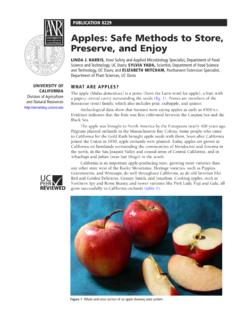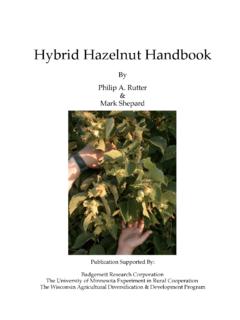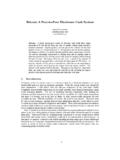Transcription of PRUNE FRUIT TREE,HOW AND WHEN
1 Ten basics Of When And How To PRUNE FRUIT Trees Mario Moratorio 1. PRUNE FRUIT trees when the leaves are off (dormant). It's easier to see what you are doing and removal of dormant buds (growing points) invigorates the remaining buds. Summer pruning removes leaves (food manufacture), will slow FRUIT ripening, and exposes FRUIT to sunburn. Summer pruning can be beneficial, however, when used to slow down overly vigorous trees or trees that are too large. It usually done just after harvest. 2. Right after planting a new tree , cut if off to short stick 24 to 30 inches high and cut any side shoots, remaining below that, to one bud. This encourages low branching and equalizes the top and root system. Paint the tree with white latex paint to protect it from sunburn and borer attack 3. Young trees should be pruned fairly heavily and encouraged to grow rapidly for the first 3 years without any FRUIT .
2 Leave most of the small horizontal branches untouched for later fruiting. 4. When deciding which branch to cut and where to cut it, remember that topping a vertical branch encourages vegetative growth necessary for development of the tree and opens the tree to more sunlight. Topping horizontal branches is done to renew fruiting wood and to thin off excessive FRUIT . Horizontal branches left uncut will bear earlier and heavier crops. 5. Upright branches generally remain vegetative and vigorous. Horizontal branches generally are more fruitful. A good combination of the two is necessary, for fruiting now and in future years. Remove suckers, water sprouts and most competing branches growing straight up into the tree . Downward bending branches eventually lose vigor and produce only a few small FRUIT ; cut off the part hanging down. 6. New growth occurs right where you make the cut; that is the influence of the cut only affects the buds within 1 to 8 inches of the cut surface not 3 to 4 feet down into the tree .
3 The more buds cut off the more vigorous the new shoots will be. 7. Do most of the pruning in the top of the tree so that the lower branches are exposed to sunlight. Sun exposed wood remains fruitful and producers the largest FRUIT . Shaded branches eventually stop producers the largest FRUIT . Shaded branches eventually stop fruiting and will never produce without drastic topping and renewal of the entire tree . 8. Make clean cuts (within 1/4") of bud; don't leave stubs. 9. Use spreaders or tie downs to get 45^ angles branches of upright vigorous growing trees. 10. Peach and Nectarine remove 50% of last years growth. Fig, Apple, Pear, Plum and Apricot remove about 20% of last years growth. Cherries only summer PRUNE the first 5. years.








